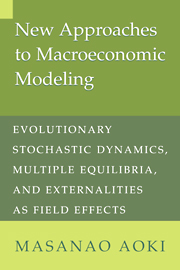 New Approaches to Macroeconomic Modeling
New Approaches to Macroeconomic Modeling 2 - Simple Illustrative and Motivating Examples
Published online by Cambridge University Press: 05 May 2010
Summary
This chapter introduces concepts and techniques that are further developed in the main body of this book, mostly via simple examples. The objective is to introduce to the reader our approaches, viewpoints, and techniques of modeling that are possibly unfamiliar to the economics profession, and to illustrate them in simple context so that basic ideas can be easily grasped. For simplification, some examples are artificial, but suggestive enough to demonstrate relevance of the notions or methods in more realistic macroeconomic models.
The examples focus on the statistical, dynamic, and state-space properties of economic variables and models. They help to introduce to the reader the notions of distinguishable and exchangeable microeconomic agents, multiplicity of microeconomic states and entropy as a measure of multiplicity, empirical distributions and related topics such as Sanov's theorem and the Gibbs conditional principle, and dynamics on trees, among others.
All of these examples are intended to suggest why certain concepts or modeling techniques, possibly not in the mainstream of the current macroeconomic literature, are useful in, or provide a new way of examining, aggregate behavior of a large number of interacting microeconomic agents.
Stochastic descriptions of economic variables
We treat all micro- and macroeconomic variables as random variables or stochastic processes, although macroeconomic variables become deterministic in the limit of the number of microeconomic units approaching infinity. Relationships among economic variables are statistical in an essential way, and are not made so by having additive disturbances or measurement errors superimposed on deterministic relationships.
Information
- Type
- Chapter
- Information
- New Approaches to Macroeconomic ModelingEvolutionary Stochastic Dynamics, Multiple Equilibria, and Externalities as Field Effects, pp. 10 - 39Publisher: Cambridge University PressPrint publication year: 1996